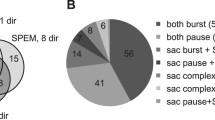Summary
Head velocity-related modulations in Purkinje cell activity were observed in lobules VI and VII of the cerebellar vermis. The sensitivities and phase shifts with respect to head velocity of Purkinje cells were comparable with vestibular responses observed in the fastigial nuclei. The results support the hypothesis of a vermal target velocity correlate and necessitate the inclusion of vermal lobules VI and VII among the cerebellar regions involved with vestibular information processing.
Similar content being viewed by others
References
Batini C, Buisseret-Delman C, Corvisier J, Hardy O, Jassik-Gerschenfeld D (1978) Brain stem nuclei giving fibers to lobules VI and VII of the cerebellar vermis. Brain Res 153: 241–261
Berthoz A, Llinás R (1974) Afferent neck projection to the cat cerebellar cortex. Exp Brain Res 20: 385–402
Blair S, Gavin M (1979) Modification of the macaque's vestibuloocular reflex after ablation of the cerebellar vermis. Acta Otolaryngol 88: 235–243
Brodal A, Høivik B (1964) Site and mode of termination of primary vestibulo-cerebellar fibres in the cat. Arch Ital Biol 102: 1–21
Duensing F, Schaefer KP (1958) Die Aktivität einzelner Neurone im Bereich der Vestibulariskerne bei Horizontalbeschleunigungen unter besonderer Berücksichtigung des vestibulären Nystagmus. Arch Psychiatr Nervenkrankh 198: 225–252
Ferin M, Grigorian RA, Strata P (1971) Mossy and climbing fiber activation in the cat cerebellum by stimulation of the labyrinth. Exp Brain Res 12: 1–17
Fuchs AF, Kornhuber HH (1969) Extraocular muscle afferents to the cerebellum of the cat. J Physiol (Lond) 200: 713–722
Fuchs AF, Robinson DA (1966) A method for measuring horizontal and vertical eye movements chronically in the monkey. J Appl Physiol 21: 1068–1070
Furuya N, Kawano K, Shimazu H (1975) Functional organization of vestibulofastigial projection in the horizontal semicircular canal system in the cat. Exp Brain Res 24: 75–87
Gardner EP, Fuchs AF (1975) Single-unit responses to natural vestibular stimuli and eye movements in deep cerebellar nuclei of the alert Rhesus monkey. J Neurophysiol 38: 627–649
Haines DE (1975) Cerebellar cortical efferents of the posterior lobe vermis in a prosimian primate (Galago) and the tree shrew (Tupaia). J Comp Neurol 163: 21–40
Ito M, Yoshida M (1966) The origin of cerebellar-induced inhibition of Deiters neurones. I. Monosynaptic initiation of the inhibitory postsynaptic potential. Exp Brain Res 2: 330–349
Ito M, Yoshida M, Obata K, Kawai N, Udo M (1970) Inhibitory control of intracerebellar nuclei by the Purkinje cell axons. Exp Brain Res 10: 64–80
Kimm J, Hassul M, Cogdell B (1976) Fastigial neuronal responses to sinusoidal horizontal rotation. Exp Neurol 50: 579–594
Kotchabhakdi N, Walberg F (1978) Primary vestibular afferent projections to the cerebellum as demonstrated by retrograde axonal transport of horseradish peroxidase. Brain Res 142: 142–146
Precht W, Volkind R, Blanks RHI (1977) Functional organization of the vestibular input to the anterior and posterior cerebellar vermis of the cat. Exp Brain Res 27: 143–160
Rashbass C (1961) The relationship between saccadic and smooth tracking eye movements. J Physiol (Lond) 159: 326–338
Robinson DA (1971) Models of oculomotor neural organization. In: Bach-Y-Rita P, Collins CC, Hyde JE (eds) The control of eye movements. Academic Press, New York, pp 519–538
Schaefer KP, Meyer DL (1981) Aspects of vestibular compensation in Guinea pigs. In: Floher H, Precht W (eds) Lesioninduced neuronal plasticity in sensorimotor systems. Springer, Berlin, Heidelberg, New York, pp 197–207
Shimazu H, Smith CM (1971) Cerebellar and labyrinthine influences on single vestibular neurons identified by natural stimuli. J Neurophysiol 34: 493–508
Snider RS, Stowell A (1944) Receiving areas of the tactile, auditory, and visual systems in the cerebellum. J Neurophysiol 7: 331–357
Suzuki DA, Noda H, Kase M (1981) Visual and pursuit eye movement-related activity in posterior vermis of monkey cerebellum. J Neurophysiol 46: 1120–1139
Thach WT (1972) Cerebellar output: properties, synthesis and uses. Brain Res 40: 89–97
Young LR, Forster JD, Van Houtte N (1968) A revised stochastic sampled data model for eye tracking movements. In: Fourth Annual NASA — University Conference on Manual Control. University of Michigan, Ann Arbor, MI, pp 489–508
Author information
Authors and Affiliations
Additional information
Supported by NIH Grant 5 RO1 EY0380-03, NSF Grant BNS-8107111, and the Smith-Kettlewell Eye Research Foundation
Rights and permissions
About this article
Cite this article
Suzuki, D.A., Keller, E.L. Vestibular signals in the posterior vermis of the alert monkey cerebellum. Exp Brain Res 47, 145–147 (1982). https://doi.org/10.1007/BF00235896
Received:
Accepted:
Issue Date:
DOI: https://doi.org/10.1007/BF00235896




